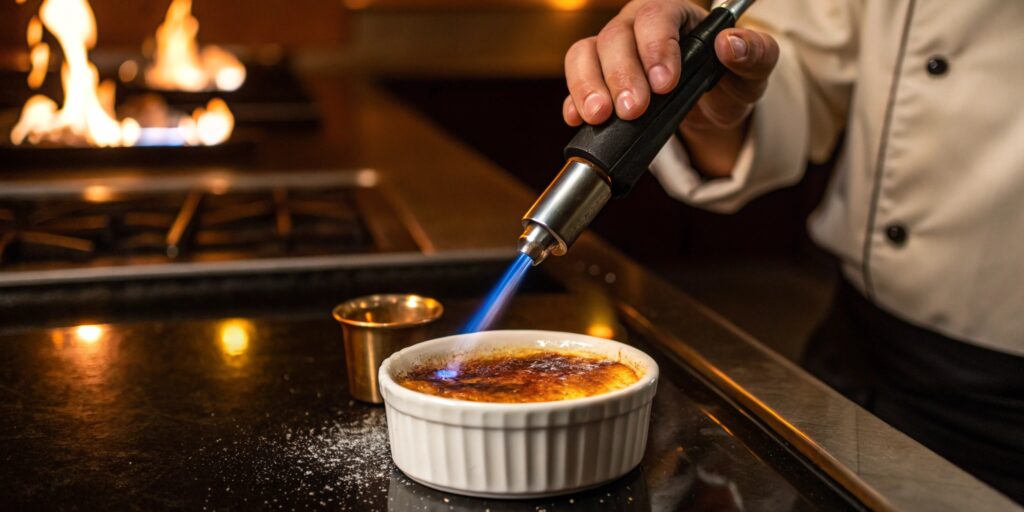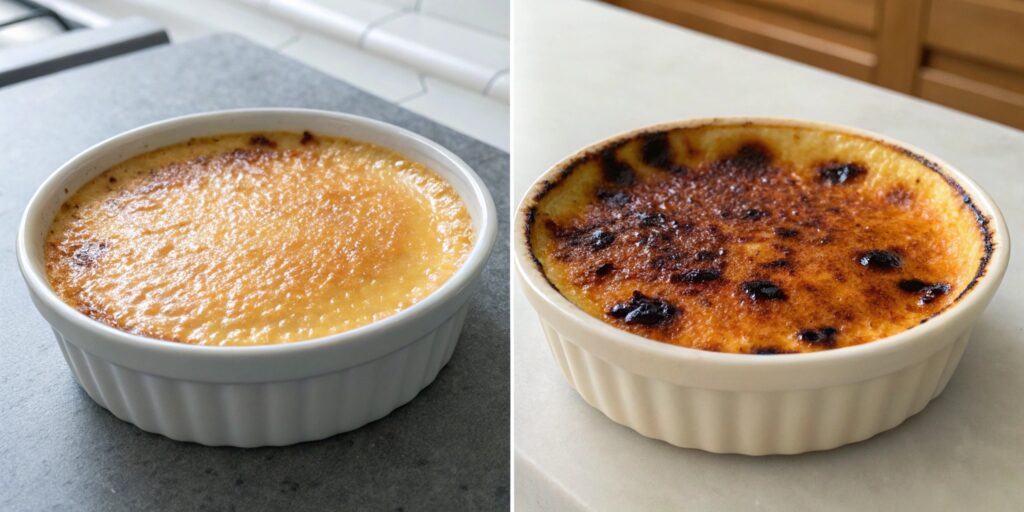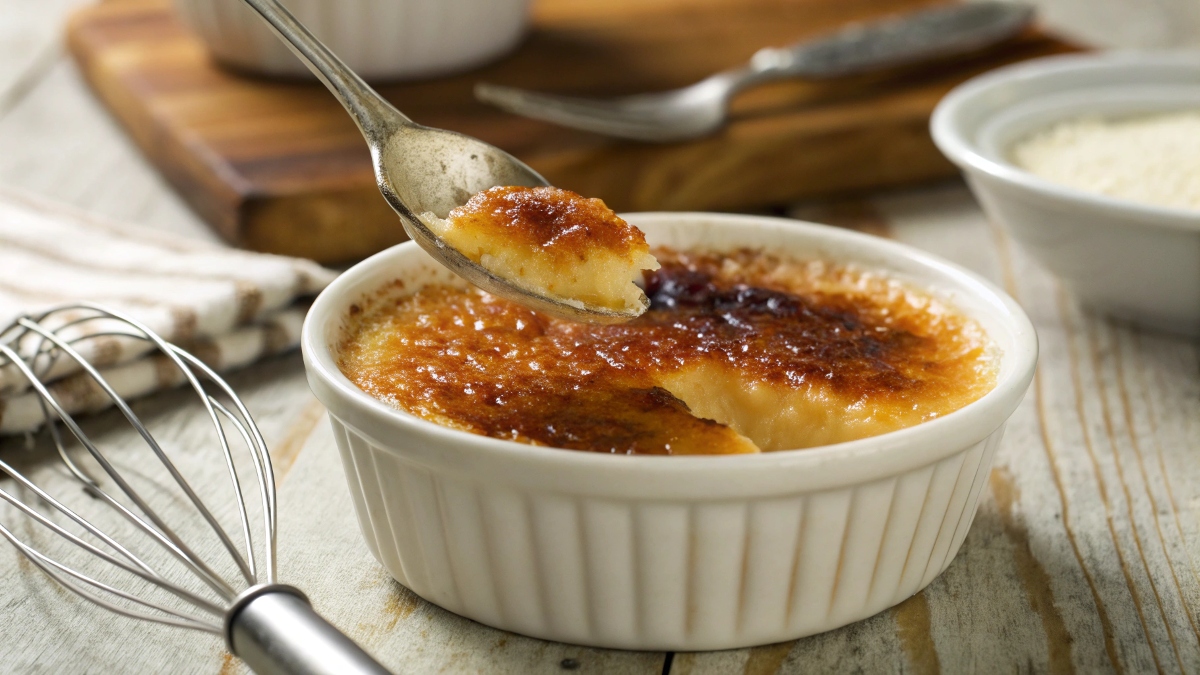Crème brûlée is undeniably a beloved French dessert, primarily recognized for its rich custard base and its signature caramelized sugar topping. Traditionally, a butane torch is the preferred tool for achieving that perfectly golden crust. However, what if you don’t have one readily available? Fortunately, you don’t need to worry! There are still several effective ways to enjoy a flawless crème brûlée using alternative kitchen tools. In this guide, we will explore the best methods to caramelize crème brûlée without a torch. As a result, you can still experience that satisfying crunch with every bite.
Table of Contents
- Understanding the Purpose of a Crème Brûlée Torch
- Is It Possible to Caramelize Without a Torch?
- The Best Alternatives to a Crème Brûlée Torch
- Step-by-Step Guide for Each Method
- Comparing the Results: Torch vs. Alternatives
- Expert Tips for the Best Caramelized Crème Brûlée
- Frequently Asked Questions
- Conclusion
Understanding the Purpose of a Crème Brûlée Torch

The primary reason a crème brûlée torch is used is that it allows you to create an evenly caramelized sugar topping without affecting the custard beneath. Since the torch emits an intense, direct flame, it melts and caramelizes sugar almost instantly, producing a crisp, golden-brown layer.
How a Torch Creates the Signature Caramelized Crust
A torch’s high heat quickly melts sugar, effectively breaking it down into caramelized compounds. Consequently, this process, known as the Maillard reaction, develops a deep, rich flavor and a crispy texture. Unlike an oven, which may heat the custard itself, a torch ensures that only the sugar is caramelized.
Is It Possible to Caramelize Without a Torch?
Absolutely! Although a torch is undeniably the most convenient tool, there are still several alternative methods available that can produce a beautifully caramelized crust. Moreover, these methods require only common kitchen equipment, which makes crème brûlée accessible to everyone.
The Best Alternatives to a Crème Brûlée Torch
Fortunately, if you don’t have a torch, you can try one of these easy methods to caramelize your crème brûlée:
1. Using an Oven Broiler 🔥
The oven broiler is an incredibly powerful heat source that can closely mimic the effect of a torch. It evenly distributes heat over the sugar, caramelizing it from above.
- First, set your oven to the highest broil setting.
- Next, place the crème brûlée on the top rack, as close to the broiler as possible.
- Then, broil for 2-5 minutes while keeping a close eye to prevent burning.
2. The Spoon Method 🥄
If you have a metal spoon, you can heat it over a gas flame and then press it onto the sugar. As a result, the heat transfers, melting and caramelizing the sugar.
- First, hold a metal spoon over a stovetop flame until it becomes very hot.
- Then, carefully press the spoon onto the sugar to caramelize it.
- Finally, repeat the process across the entire surface for even caramelization.
3. Caramelizing with a Stovetop 🔥
Another effective method involves melting sugar in a pan and then pouring it over the custard.
- Begin by heating sugar in a dry pan over medium heat until it melts and turns amber.
- Quickly drizzle the hot caramel over the crème brûlée.
- Allow it to cool and harden before serving.
4. The Candle Lighter Trick 🕯️
Alternatively, a long-reach candle lighter can be used in a manner similar to a torch. However, this method requires more time and patience.
- First, hold the flame close to the sugar while moving it around slowly.
- Then, repeat until the entire surface is evenly caramelized.
Step-by-Step Guide for Each Method
Now that we have explored the alternatives, let’s go through a detailed guide to help you achieve the best results.
Preparing Your Crème Brûlée for Caramelization
Before you begin caramelizing, ensure that your custard is completely chilled. Otherwise, warm custard can become runny under high heat, which may ruin the texture.
Method 1: Broiling for an Even Crust
- First, set your broiler to high and preheat for at least 5 minutes.
- Next, sprinkle an even layer of sugar on top of the custard.
- Then, place the ramekins on a baking sheet and position them under the broiler.
- Finally, watch closely and remove them once the sugar turns golden brown.
Method 2: Heating Sugar in a Pan
- To begin, use a non-stick pan to melt sugar without adding water.
- Then, stir continuously until the sugar turns golden brown.
- Finally, carefully pour the melted caramel over the crème brûlée.
Method 3: Using a Heated Spoon
- First, heat a metal spoon directly over a gas burner.
- Then, once it becomes extremely hot, press it against the sugar.
- Repeat the process across the surface until evenly caramelized.
By using these methods, you can still enjoy a perfectly caramelized crème brûlée at home—without needing a fancy torch!
For additional tips on perfecting crème brûlée, check out What is the Secret of Crème Brûlée?.
Comparing the Results: Torch vs. Alternatives
Now that we’ve explored various alternative methods for caramelizing crème brûlée, it’s time to compare how they measure up against the traditional butane torch. Clearly, each method has its own strengths and limitations, depending on the equipment you have available and the texture you prefer.
Which Method Gives the Best Crust?
For a perfect crème brûlée, the crust should be thin, crisp, and evenly caramelized. To illustrate the differences, let’s examine how each method compares:
| Method | Crust Texture | Even Caramelization | Ease of Use |
|---|---|---|---|
| Butane Torch | Thin & crispy | ✔️ Perfectly even | ✔️ Very easy |
| Oven Broiler | Slightly thicker, sometimes uneven | ❌ Can overheat custard | ✔️ Easy, but requires monitoring |
| Heated Spoon | Patchy & thicker | ❌ Hard to control | ❌ Requires patience |
| Stovetop Caramel | Hard & brittle | ✔️ Even but thick | ✔️ Easy |
| Candle Lighter | Thin but uneven | ❌ Takes longer | ❌ Difficult |
Pros and Cons of Each Alternative
Of course, each method has its trade-offs. To clarify, here’s what you can expect from each alternative:
- Oven Broiler: This is the easiest method; however, it may heat the custard too much.
- Heated Spoon: While it works in a pinch, it is difficult to control and can lead to uneven results.
- Stovetop Caramel: This method ensures even caramelization, yet the crust often turns out too hard.
- Candle Lighter: Although it is an option, it takes too long and is not particularly effective.
Expert Tips for the Best Caramelized Crème Brûlée
If you want a flawlessly caramelized topping, these expert tips will help you achieve the best results.
Choosing the Right Sugar for Caramelization
Not all sugars behave the same way when caramelizing. To ensure success, consider these options:
- White Granulated Sugar: This is the best choice for achieving an evenly caramelized crust.
- Turbinado Sugar: It adds a deeper caramel flavor; however, it takes longer to melt.
- Brown Sugar: While it enhances richness, it burns faster, so careful monitoring is required.
For optimal results, always use fine granulated sugar and spread it evenly over the custard.
Ensuring Even Heat Distribution
To achieve an evenly caramelized crust, keep the following tips in mind:
- When using the broiler, rotate the ramekins halfway through to ensure uniform caramelization.
- Always use a thin layer of sugar, as too much can lead to a burnt or grainy texture.
- For the stovetop caramel method, pour the melted sugar quickly before it hardens.
Avoiding Common Mistakes

Caramelizing crème brûlée can sometimes be tricky. To help, here are some common mistakes and how to avoid them:
- Sugar won’t caramelize: If this happens, your heat source may not be hot enough.
- Custard turns runny: Overheating under the broiler can cause the custard to melt.
- Crust is too thick: Reduce the amount of sugar and ensure an even, thin layer.
Frequently Asked Questions
What is the Secret to Crème Brûlée?
The secret lies in a perfectly balanced custard and a thin, crisp sugar crust. By using the right amount of sugar and proper caramelization techniques, you can achieve the ideal texture.
What’s the Difference Between Crème Brûlée and Custard?
Although both are creamy desserts, crème brûlée stands out due to its caramelized sugar topping. Regular custard, on the other hand, lacks this signature crunchy layer. Learn more here.
What Can I Use Instead of Ramekins for Crème Brûlée?
If you don’t have ramekins, don’t worry! You can use small oven-safe bowls or even teacups. To explore more options, check out this guide for alternatives.
Conclusion: Enjoying Crème Brûlée Without a Torch
Crème brûlée is an elegant dessert that should never be out of reach, even if you don’t own a butane torch. With several alternative methods available, you can still achieve that irresistible caramelized crust with tools you likely already have at home.
Final Thoughts on the Best Method
While each method has its pros and cons, the oven broiler is the most accessible and effective way to caramelize crème brûlée without a torch. If you’re looking for the closest alternative, this method delivers the best results with minimal risk of overheating the custard.
If you’re feeling adventurous, stovetop caramelization is another reliable choice, offering complete control over the sugar’s texture and consistency. However, if you want to stick as close as possible to the traditional torching method, a heated metal spoon might be worth a try.
Pairing Crème Brûlée with the Perfect Side Treats
Want to enhance your dessert experience? Pair crème brûlée with complementary flavors! Here are some delightful pairings:
- Fresh Berries: The tartness of raspberries or strawberries balances the richness of the custard.
- Espresso or Coffee: The deep flavors of coffee contrast beautifully with the sweet caramel crust.
- Shortbread Cookies: A buttery, crumbly cookie pairs wonderfully with the creamy dessert.
More Crème Brûlée Tips & Tricks
Still perfecting your crème brûlée game? Explore these additional guides:
- What is the Secret of Crème Brûlée? – Learn the key to achieving the perfect custard texture and caramelized top.
- What’s the Difference Between Crème Brûlée and Custard? – Understand how crème brûlée stands apart from other custards.
- What Can I Use Instead of Ramekins for Crème Brûlée? – Discover creative alternatives to ramekins when making crème brûlée.
- Crab Brûlée Recipe – Try a unique take on crème brûlée with a savory seafood twist!
Final FAQs
Can I Make Crème Brûlée Without a Torch and Still Get a Crisp Crust?
Yes! The best way is to use an oven broiler, which mimics the effect of a torch. The trick is to monitor it closely to prevent overheating the custard.
What’s the Best Type of Sugar for Crème Brûlée?
White granulated sugar is the best choice because it melts evenly and caramelizes quickly. Avoid large sugar crystals as they take longer to caramelize and may result in uneven texture.
Can I Use a Lighter Instead of a Torch?
Technically, yes, but it’s not recommended. A standard lighter doesn’t produce enough heat, making the process slow and uneven. If using a lighter, opt for a long-reach candle lighter for better control.
Why Did My Caramelized Sugar Turn Soft Instead of Crispy?
Moisture is the likely culprit. Ensure your custard is completely chilled before caramelizing. Also, serve the crème brûlée immediately after caramelization to maintain the crisp crust.
Can I Make Crème Brûlée in Advance?
Yes! You can prepare the custard a day ahead and store it in the fridge. However, only caramelize the sugar layer right before serving to ensure a crunchy topping.
What If I Burn the Sugar?
A slightly bitter taste from caramelized sugar is normal, but if the sugar turns black, it’s burnt. To avoid this, use even layers of sugar and monitor the process closely, whether using a broiler, stovetop, or heated spoon.
Are There Any Other Ways to Caramelize Crème Brûlée?
If none of the above methods work for you, try using a hot metal skewer. Heat the skewer over a flame until red hot and gently press it onto the sugar layer for a caramelized effect.
Enjoy Your Homemade Crème Brûlée – No Torch Needed! 🎉
Even without a butane torch, making perfect crème brûlée at home is absolutely possible! With the right tools and techniques, you can achieve a beautifully caramelized sugar crust that cracks just right when tapped with a spoon.
Which method are you excited to try? Let us know in the comments, and don’t forget to check out our Crab Brûlée Recipe for a delicious savory twist on this classic dessert!

